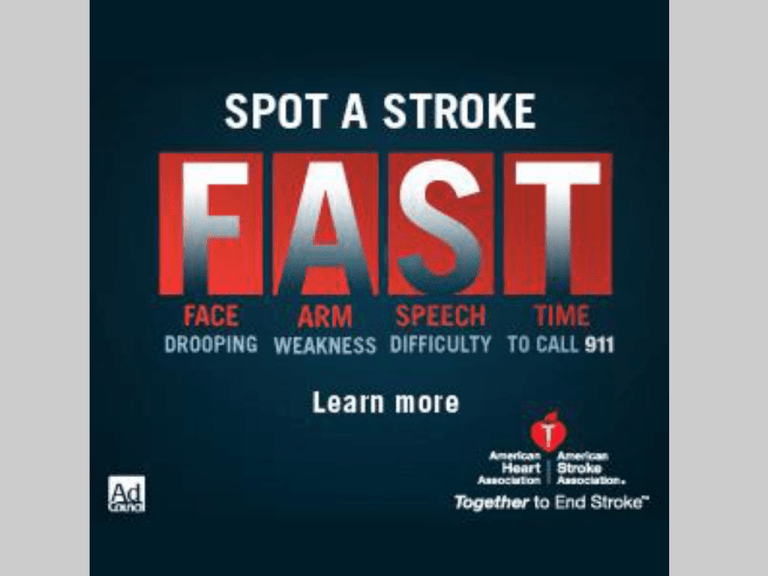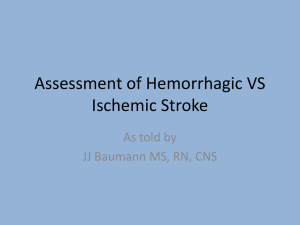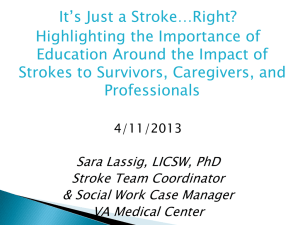
How Good is Your Stroke Scale?
Sean Kivlehan, MD, MPH, NREMT-P
September 2013
Outline
• Stroke Review
• Treatment review
– Rehab tPA recognition & time matters
• Scale development and flaws
• Systems issues
• Future directions
Case #1
62 year old male, low speed MVC into pole,
conscious with flaccid left arm, facial droop, and
slurred speech. BP 220/100
Case #2
89 year old female, daughter called because she
has been vomiting for past 2 hours, is dizzy, and
can’t stand. No facial droop, normal speech, no
focal weakness. BP 220/100. Actively vomiting.
Case #3
70 year old female found down in her
apartment when son went to check on her. Last
seen normal at dinner last night. Now semiconscious but following commands, not moving
right side. BP 200/90.
We’ve come far but still have a long way…
HISTORY
“Apoplexy”
•
•
•
•
•
What they called it from Hippocrates on…
1950’s: TIA’s
25 years ago: Imaging
10 years ago: Imaging in community hospitals
1970 WHO definition: “rapidly developing clinical
signs of focal (or global) disturbance of cerebral
function, lasting more than 24 hours or leading to
death, with no apparent cause other than that of
vascular origin.”
Sacco 2013
TIA’s
1975: “episodes of temporary and focal dysfunction
of vascular origin, which are variable in duration,
commonly lasting from 2 to 15 minutes, but
occasionally lasting as long as a day (24 hours).
They leave no persistent neurological deficit.”
2002: “A TIA is a brief episode of neurologic
dysfunction caused by focal brain or retinal
ischemia, with clinical symptoms typically lasting
less than one hour, and without evidence of acute
infarction.”
Unclear
2009: “a transient episode of neurological
dysfunction caused by focal brain, spinal cord, or
retinal ischemia without acute infarction.”
What is a Stroke Today?
1. Ischemic Stroke
(clot: thombotic vs embolic) – 87%
2. Hemorrhagic Stroke
(bleed: intracerebral vs subarachnoid; aneurysms & AVM’s) – 13%
3. Transient Ischemic Attack (TIA)
Caused by clot, last <5 min, no permanent injury
A long way to go
• Number 4 cause of death in US (down from #3
in 2008)
• 785,000 in US a year
• Less than half of 911 calls made within 1 hour
of onset
• Newest AHA/ASA outreach: FAST
– 1 of 3 in 88% of strokes
– Recalled well in 3 months (public)
• Only 53% of strokes arrive by EMS in US
Jauch 2013
Vessels & Risk
ANATOMY OF A STROKE
Where is the Stroke?
• Anterior Circulation
– Weakness
– Aphasia
– Sensory deficit
• Posterior Circulation
– Dizzy
– Vomiting
– Ataxia
Now that we have the vessels down, how do they get messed
up?
Source: Arizona.edu
Ischemic
Hemorrhagic
40% mortality @ 30 days!
Sacco 2013
What Causes These Things?
•
•
•
•
•
•
Embolic
Bacterial emboli from
valvular vegetations
Blood clots from cardiac
dysrhythmias
Platelet-fibrin complex
from atherosclerotic
plaque disruption
Septic emboli from
infection
Fat emboli from traumatic
injury
Particulate emboli from IV
drug injection
Thrombotic
• Secondary to intrinsic
vascular disease in the
occluded vessel
• Atherosclerotic disease
most common cause in
U.S.
• Other causes include
–
–
–
–
Vasculitis
Hypercoagulable states
Polycythemia
Vascular dissection
Risk
•
•
•
•
CAD: Double
HTN: Triple
Cardiac Failure: Quadruple
A-Fib: Quintuple
Wolf, Stroke, 1991
And what about those TIA’s?
• 4 to 20% will progress to stroke within 90 days
• Half of those in first 24 hours
• ABCD2 score
– Age (>60)
– Blood Pressure (>140/90)
– Clinical Features (weakness/speech)
– Duration (>60 minutes)
– Diabetes
Koenig, NEJM, 2007
From Rehab to Cure
TREATMENT
Treatment
Old teaching – 5 pages out of 1100
Focused on recognition, managing airway,
manage herniation symptoms
Suddenly, a cure!
What we KNOW
•
•
•
•
•
Earlier recognition Earlier EMS
Earlier EMS Earlier ED notification
Earlier ED notification Earlier imaging
Earlier imaging Earlier tPa
Earlier tPa Better outcomes
AHA Implementation Strategy for EMS within Stoke Systems of Care (1997)
Key Things
•
•
•
•
Check a sugar
And the pupils!
Prior stroke/seizures?
Time of onset!
– Wake up strokes
• Stroke mimickers
EMS Interventions
• ABC’s etc
• Oxygen to maintain SpO2 >94%
• Head of bed flat for SBP <120 and give isotonic
saline
• Antihypertensive treatment controversial (>220)
• Glucose if FS <60
• Establish PIV
• Labs if build into system
• None of this should delay transport
Jauch 2013
The most important piece of info….
• Time patient last seen normal
• EMS often the only people that can get this info on scene
(family, bystanders)
• Also:
–
–
–
–
–
–
Signs of hx of seizures or trauma on scene
PMHx (prior stroke, diabetes, HTN, AF
Meds on scene (anticoagulants)
Recent illness, surgery, trauma
Collect phone numbers, code status, family members
Bring family to ED
EMS are the eyes & ears of the ED
tPA (Fibrinolytic Therapy)
• FDA approved in 1996 for 3 hour window
• Showed symptom improvement at 24 hours
and 1 year (OR 1.9; CI 1.2-2.9)
• ICH: 6.4% in tPA and 0.6% in placebo
• 3 to 4.5 hour window w/ extra exclusions
• 4.5 to 6 hour window did not help
NINDS, NEJM, 1995
Jauch 2013
Mechanical Retrieval & IA tPA
•
•
•
•
•
Merci
Penumbra
Solitaire
Trevo
IA tPA ok for up to 6 hours
– Good for patients with IV tPA contraindications
– Can give in addition to IV tPA
So Now, TIME MATTERS
And we need to Recognize
Can we?
1995: Reading EMS (Ohio)
58 months, 4,413 patients
96 (2%) dx with stroke or TIA by EMS
10 excluded (lost data)
86 62 (72%) dx with stroke or TIA in ED
So, 24 patients (28%) were misdiagnosed by EMS (false
positive)
Dispatch: 30 of 62 dispatched as something other than stroke
BUT WE DON’T KNOW: how many people were having strokes
& EMS called it something else?
Kothari, 1995
Maybe it’s because of the education?
The NIH Stroke Scale
WHO IS HAVING A STROKE?
What they did in Cincinatti
• NIH stroke scale – huge & takes a while
• Watered it down to what matters:
– Facial palsy
– Asymmetric arm weakness
– Speech abnormalities
100% Sensitivity
88% Specificity
Kothari, 1997
What does that mean?
• Sensitivity: True Positive
(you found all strokes)
• Specificity: True Negative
(you found all non strokes)
• So this test (in theory):
– Catches every stroke
– 1 in 9 aren’t really having a stroke (false positive)
Who was falsely labeled?
(also, our differential)
•
•
•
•
•
•
Seizure (3)
Alcohol Intox (3)
Cardiac Arrest (2)
Abdominal Pain (2)
Dizziness/Vertigo (2)
Sepsis/Pneumonia (2)
Limitations
• Done by ED Physicians (not EMS)
• Stroke patients were sick – enrolled in stroke
trial
• Done in hospital (not in field)
• Misses posterior circulation strokes
Next: Test on EMS
• 24 EMS Providers (17 medics, 7 EMTs)
• 4 EMS providers & 1 ED physician did CPSS on
each patient
• 860 scales on 171 patients (38 with stroke, 11
with TIA)
• Scoring for each component same between ED
physician, Medic, EMT
• CPSS had sensitivity 59% and specificity 89%
• Missed: 10 posterior circ & 3 anterior circ
(atypical)
Kothari 1999
Paramedics vs Physicians
Nor 2004
Kothari 1999
What about this posterior circ thing?
• 10/14 were missed!
• Testing ataxia would have caught 6/10
• Downplayed: ataxia difficult to reproduce,
least reproducible item on NIHSS, rarely
treated w/ tPa
Kothari 1999
What happened?
• 1997: all stroke dx patients were in a
thrombolytic trial, so they had more severe
symptoms and all received tPa
• 1999: neurologists were asked to find stroke
mimickers, and stroke patients were just
“discharge dx” of stroke, didn’t necessarily get
tPa
1997
1999
Sensitivity
100%
59%
Specificity
88%
89%
Did it get better?
• San Diego, 2005, 12 month period, 86,989 calls
• Matched CAD (stroke), EMS report w/ CPSS done
& stroke dx, & hospital ICD-9’s by billing info
• Dispatch as stroke: 2,140 (2%) 882 to study
hospital 367 (42%) hospital stroke dx
• EMS dx as stroke: 995 (1.3%) 493 to study
hospital 193 (40%) hospital stroke dx
• Missed: Dispatch: 73, EMS: 247
Ramanujam 2008
Verdict?
• EMS Sensitivity 44%, PPV 40%
• Flaws: didn’t follow all patients in SD, so don’t
really know true neg.
• Possible data is missing, or labeled “AMS etc”
• Others?
– Bray – 78% sensitivity
– No scale (Smith) – 61% sensitive, PPV 77%
Nail in the coffin?
• Durham, 2004
• They use CPSS
• All transports are discretely coded (so no
missed EMS dx’s)
• Hospital (Duke) has stroke registry, compared
this to EMS transports’ dx’s
Frendl 2009
Durham
• 184 EMS stroke/TIA charts
• 30 excluded (uncon), leaving 154
• CPSS only used on 37% of stroke patients!
• 70% of patients w/ actual stroke had at least 1
CPSS finding (Sensitivity)
• 52% of patients w/ CPSS finding had a stroke
(Specificity)
• No effect of scene time or L&S use to ED
Frendl 2009
What are you goals?
• IF: identify greatest # of stroke patients, then add
more elements (11% of missed strokes had grip
strength/visual deficit/numbness or tingling)
• BUT: if you are going to active stroke teams off of
this, this will put false positives through the roof
• IF: justify transport diversion, then the specificity
NEEDS to increase.
• Is it better to bypass a patient’s primary hospital
when we are only right half of the time?
PRO
CON
No missed strokes
Loss of Continuity
Best care for stroke patients
Increased cost (system & patient)
EMS unit OOS time
Accident Risk
Another option?
• Yes – the competitor! LAPSS
• Starts with exclusions:
–
–
–
–
–
>12 hour onset
Age <45 yo
Hx seizures
Wheelchair/bedbound
Finger stick <50 or >400
• Then does:
– Arm weakness
– Grip Testing
– Facial droop
Kidwell 1998
LAPSS
• Plans to miss:
– Isolated visual field cuts
– Isolated aphasias
– Brainstem & Cerebellar infarcts
• This is in the name of increasing specificity
• Focuses on motor deficits
• Tested by ED physicians retrospectively on known
stroke patients in thrombolytic trial (similar to CPSS),
93% sensitive
• Held up in testing – 89% sensitive & 99% specific
• Kidwell 2000
Kidwell 1998
The Australians
• Studied CPSS vs LAPSS
…and threw in their own, the MASS
(Melbourne Ambulance Stroke Screen)
– Supposed to be a combo of the 2
– Showed better sens/spec but the approach was
flawed – didn’t track stroke discharge from hospital
(so we have no idea how many were missed)
• “Faster Access to Stroke Therapies (FAST)” study
Bray 2005
MASS?
•
•
•
•
•
Facial Droop
Unilateral hand grip/weakness
Unilateral arm drift
Slurred/abnormal speech
ADDS: rule out mimics
– <45 yo
– Hx seizures/epilepsy
– Abnormal BSL
Bray 2005
Bray 2010
Bray 2005
The British don’t want to be left out
• Face Arm Speech Test (FAST)
• Same as CPSS but you don’t need the patient
to repeat the sentence
• Validated in Newcastle, UK
– EMS caught 144/183 (79%) of strokes
– Still high levels of missed posterior strokes
– Can’t measure the false negatives (a theme)
Harbison 2003
Scale Summary
• CPSS: based off of NIHSS, misses post circ
• LAPSS: Longer, but rules out non-tpa
candidates and increases specificity
• FAST: Even quicker than CPSS, basically the
same thing, from the UK
• MASS: Combo of the CPSS & LAPSS, building
on strengths, from Australia
Wait – There’s More!
• Miami Emergency Neurological Deficit (MEND)
• Precursor to new Advanced Stroke Life
Support (ASLS) course
• CPSS + 6 more NIHSS components
– level of consciousness, orientation, commands,
visual fields, gaze, leg motor, limb ataxia,
sensation
Brotons 2012
Ontario
• CPSS w/ more exclusions
Chenkin 2009
Case #1
62 year old male, low speed MVC into pole,
conscious with flaccid left arm, facial droop, and
slurred speech. BP 220/100
Right MCA (anterior circulation), positive on all
scales
Case #2
89 year old female, daughter called because she
has been vomiting for past 2 hours, is dizzy, and
can’t stand. No facial droop, normal speech, no
focal weakness. BP 220/100. Actively vomiting.
Posterior circulation stroke. Abbreviated scales
negative, NIHSS positive.
Case #3
70 year old female found down in her
apartment when son went to check on her. Last
seen normal at dinner last night. Now semiconscious but following commands, not moving
right side. BP 200/90.
Left MCA, large stroke, positive on CPSS but out
of window.
Now, transport
•
•
•
•
•
Where, how
ALS v BLS
Air?
Stoke centers
Retriage
Field tPA, telemedicine, & ultrasound
FUTURE
PHANTOM-S
Pre-Hospital Acute Neurologic Therapy and Optimization of Medical Care in Stroke
• The ambulance:
– Neurologist
– Paramedic
– Radiographer
– CT Scanner
– POC Lab
– Teleradiology
• The dispatch:
– For any suspected stroke
Weber 2013
The Results
• 23 patients got tPA in 3 months
• Door-to-needle 62 minutes (vs 98 minutes)
• 2 patients bled, 1 died
Weber 2013
Source: Mayfield Clinic.com & Radiographics
Does EMS notification reduce door to
needle?
• Yes!
• And door to imaging
• And pretty much every other metric
Bae 2010, Mosley 2007
Summary
•
•
•
•
Stoke management
AHA
Scales
Transport
Why does this matter?
• EMS are the first medical contact for 38-70%
of stroke patients
• EMS recognition is key to hospital notification
• Notification shortens door-to-needle time
• That improves outcomes for stroke patients
• BUT, we are missing a LOT of stroke patients
(up to 40%)
– They go to non-stroke center or wait in triage
Bray 2005








